

The Intermedial Trajectories of Angela Carter’s Wolf Tales. 1Susannah Clapp has quoted Angela Carter as liking “anything that flickers,” (American ix) and Carter’s attraction to the cinema is apparent in both the structure and themes of her work.

She admits to a fascination for experiences of collective viewing that reach back to the Granada Tooting, a cinema from her childhood described as a “dream cathedral” which incarnated the “apotheosis of the fake” in its very architecture (Carter, “Granada” 400). In a Radio 4 (1989) interview, she comments on how the cinema had influenced her fiction: “‘I’m perfectly conscious of using all kinds of narrative technique that I’ve taken from the cinema.
Our experience of watching narrative in the cinema has completely altered the way that we approach narrative on the page, that we even read nineteenth-century novels differently’” (qtd. in Crofts 92). Intermedial concerns are indeed interlaced with Carter’s writing, as she wrote for the radio, the cinema, and television. Mrs Peacock's English Blog. This is a link to a short lecture on shocking literature of the Nineteenth Century which was delivered as part of a Lunchtime Lecture series.
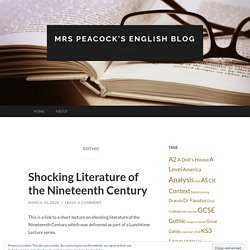
This is aimed at students studying for the OCR A Level English Literature, Drama and Poetry Pre-1900 paper. Curvelearn.com: AQA Lit B A2 English Literature 'Elements of the Gothic': Exam Questions Past Papers. Elements of the Gothic Section B exam questions for AQA Lit B A2 Written Paper: Gothic writing has been attacked as ’a species of brutality’.
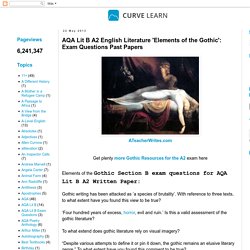
With reference to three texts, to what extent have you found this view to be true? ‘Four hundred years of excess, horror, evil and ruin.’ Is this a valid assessment of the gothic literature? To what extend does gothic literature rely on visual imagery? “Despite various attempts to define it or pin it down, the gothic remains an elusive literary genre.” Houses of horror: a rambling, teetering, crumbling brief history of gothic cinema. The gothic flame has always burned brightly in the cinema, exploring the architectural spaces of shadowed edifices: from the real Slovakian castle FW Murnau infested with rats in Nosferatu (1922) to the cobweb-draped, colossal sets Bela Lugosi inhabits for Tod Browning’s Dracula (1931).

Both approaches – finding an authentic location and increasing its gothicism with set-dressing, lighting and camera angles, or creating a gothic environment on a sound-stage with painted backdrops and elaborate art direction – persist today, and both are equally valid. The gothic mode derives initially from architecture but became a form of fiction with the 18th-century gothic novel, in which heroines were menaced in gothic buildings by satanic villains. The term persists in several art forms, through landscape painting (all thunderstorms), “goth” rock (eyeliner and romantic agony) and fashion (ragged fishnets, crushed velvet, lots of black). But at the movies, gothic isn’t limited to horror. The Intermedial Trajectories of Angela Carter’s Wolf Tales. 1Susannah Clapp has quoted Angela Carter as liking “anything that flickers,” (American ix) and Carter’s attraction to the cinema is apparent in both the structure and themes of her work.
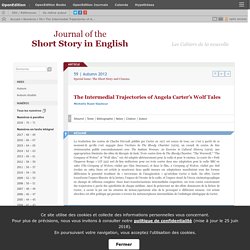
She admits to a fascination for experiences of collective viewing that reach back to the Granada Tooting, a cinema from her childhood described as a “dream cathedral” which incarnated the “apotheosis of the fake” in its very architecture (Carter, “Granada” 400). In a Radio 4 (1989) interview, she comments on how the cinema had influenced her fiction: “‘I’m perfectly conscious of using all kinds of narrative technique that I’ve taken from the cinema. Our experience of watching narrative in the cinema has completely altered the way that we approach narrative on the page, that we even read nineteenth-century novels differently’” (qtd. in Crofts 92). Angela Carter, Gothic literature and The Bloody Chamber. The Bloody Chamber is a collection of modern fairy tales, many of which incorporate elements of Gothic literature.
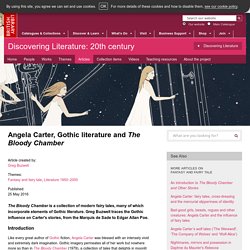
Greg Buzwell traces the Gothic influence on Carter's stories, from the Marquis de Sade to Edgar Allan Poe. Introduction Like every great author of Gothic fiction, Angela Carter was blessed with an intensely vivid and extremely dark imagination. Gothic imagery permeates all of her work but nowhere more so than in The Bloody Chamber (1979), a collection of tales that delights in moonlit forests, graveyards, isolated castles, locked rooms, guttering candles and the howling of wolves in the night. Angela Carter’s wolf tales (‘The Werewolf’, ‘The Company of Wolves’ and ‘Wolf-Alice’) The last three stories in Angela Carter's The Bloody Chamber all feature wolves.
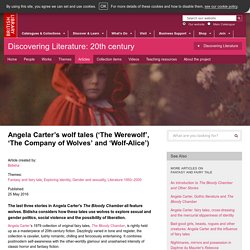
Bidisha considers how these tales use wolves to explore sexual and gender politics, social violence and the possibility of liberation. BBC Radio 3 - Free Thinking, 2015 Festival, Landmark: Angela Carter. The Scottish writer who inspired Bram Stoker's Dracula. When Bram Stoker was researching his world-famous novel Dracula one of his biggest influences was a woman who was born into a wealthy family in the Lanarkshire town of Airdrie.

One of the UK's leading literary institutions has establish how Stoker had a copy of Emily Gerard's book on Transylvanian folklore and took notes while researching his own novel. Gerard's The Land Beyond the Forest is credited with introducing Stoker to the concept of "nosferatu", a vampire-like creature who sucks the blood of innocent victims. She wrote her book after spending two years in the mid-1880s in Romania with her husband, who was posted there as an officer in the Austro-Hungarian army.
Image copyright ullstein bild Dtl. L’INTÉGRALE - Dracula et autres vampires. Dracula ou les Dents du désir. Auteur : Bram Stoker.

Bram Stoker dans l'ombre de Dracula. Si tout le monde sait que Dracula est un roman, moins nombreux sont ceux qui connaissent le nom de son auteur : Bram Stoker (1847 - 1912) fait, en effet, partie de ces écrivains que le succès de leur oeuvre a éclipsé.
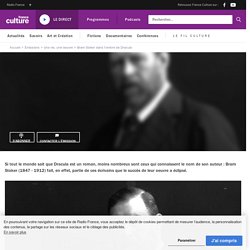
Un anonymat peu mérité puisque l'écrivain irlandais est à l'origine de l'un des plus grands mythes de l'histoire de la littérature et du cinéma : Dracula, son personnage, étant devenu l'archétype même du vampire. Qui était vraiment Bram Stoker ? Dracula, prince des ténèbres ! Retour sur la création de “Dracula” par Bram Stoker, ses inspirations, ses descendants… mais aussi Anne Rice qui a contribué à enrichir cette mythologie.
Pourquoi le vampire fascine-t-il-autant la littérature et le cinéma depuis des siècles ? FILM / Absolutely ravishing: Bram Stoker's Dracula. THEY call it Bram Stoker's Dracula, but that won't kid anyone for long. One look at the hypercharged Gothic fantasia unfurling across the screen and you realise this Dracula is the creation of someone very much of our time, someone extravagantly talented and hopelessly muddled - someone like Francis Ford Coppola, in fact. While the form of Stoker's fable has largely been retained - a patchwork of journals, letters and newspaper reports - it's been shaken down and souped up as a luscious spectacle. Coppola's pyrotechnics have gatecrashed the novel and overturned its fin de siecle furniture. From Corleone to Kurtz, Coppola has often been drawn to the enigmatic overlord who exercises a terrible and absolute power over his domain.
English Intranet - The Bloody Chamber and the Gothic. Search this site The Bloody Chamber and the Gothic The Gothic Genre: An introduction to The Bloody Chamber and Other Stories. Chris Power examines how Angela Carter’s collection of reworked fairy tales is a unique, disruptive work that places gender politics centre-stage and refuses to be easily categorised. In The Bloody Chamber we encounter some of the best-known stories in Western literature – fairy tales by Charles Perrault, Jeanne-Marie Leprince de Beaumont and the Brothers Grimm – twisted into extraordinary new shapes. The collection, published in 1979, was Angela Carter’s ninth book of fiction, and while channels of fairy tales and myth run through her prior work, nowhere does she engage with those genres so directly and disruptively as here. The journalist and critic Lorna Sage, a close friend of Carter’s and an insightful reader of her work, describes how throughout the 1970s she became ‘more explicitly and systematically interested in narrative models that pre-date the novel: fairy tales, folktales, and other forms that develop by accretion and retelling’.[1] View images from this item (19) Footnotes.
Helen Simpson on Angela Carter's Bloody Chamber. The Bloody Chamber is often wrongly described as a group of traditional fairy tales given a subversive feminist twist. In fact, these are new stories, not re-tellings. Angela Carter’s Feminist Mythology. There love is mixed with comedy. Three paragraphs later, it is mixed with death, a beautiful death: “I should have liked to have had him embalmed and been able to keep him beside me in a glass coffin, so that I could watch him all the time and he would not have been able to get away from me.” A glass coffin: “Snow White.” And that’s where she was headed—to fairy tales. BBC Arts - Books Features - Radical writing: Was Angela Carter ahead of her time? BBC Two HD Angela Carter Of Wolves & Women (2018) Dracula. The Threat of Otherness in Bram Stoker's Dracula.
1Hand in hand with scientific research on sexuality for modern culture, gothic fiction became immensely popular in the Victorian era, serving as a displaced field of any kind of sexuality that crossed the barriers or ‘normality’. In order to define normality and anomalies, the prevailing sentiment and public beliefs are determinant. Springing from Puritanism, anything apart from heterosexual monogamy was liable to cause suspicion and was regarded as a sexual dysfunction.
The paraphilias gathered by Richard von Krafft-Ebing in his famous collection of pathological case histories, Psychopatia Sexualis (1886) illustrate the social consensus on sexual normativity very well, where sexual maladjustment could result in imprisonment. More than a century later we can observe a loosening tendency compared to Victorian judgments on deviations, but I restrict my research on the last decades of the nineteenth century, and focus on anomalies which were considered some forms of deviance at the time. Au cœur de l'Histoire : Le vampire Dracula (Récit intégral) Bram Stoker's Dracula - A Documentary (FULL DOCUMENTARY) BBC Radio 4 - Was Dracula Irish? Bram Stoker: A Brief Biography. Orn in Clontarf (near Dublin, Ireland) on November 8, 1847, Bram (Abraham) Stoker is recognized as one of the most prominent Gothic authors of the Victorian fin-de-siècle. An accomplished athlete, journalist, author, biographer, theatre critic and theatre manager, Stoker is best known for his Gothic masterpiece Dracula (1897).
Like his immortal creation Count Dracula, Stoker's life is shrouded in mystery, from his rumored participation in occult circles, to his purported death from syphilis. Stoker was educated at Trinity College, "where he won honours in science, mathematics, oratory, history, and composition ("Obituary"). After graduating he entered the Irish Civil Service where he served as Inspector of Petty Sessions (Byron 9). In 1876 Stoker met the actor Henry Irving and by 1878 had moved to London where he was acting manager at the famous Lyceum Theatre. After being ill since 1906, Stoker died on a Saturday evening April 20, 1912 at 26, St.
Lists. Bram Stoker dans l'ombre de Dracula. L’espace dans le roman de Bram Stoker. 1 Au sens d’une construction imaginaire qui prend ses origines dans la réalité et dans des personnage (...) 2 Région par-delà les forêts, la Transylvanie est une vieille province historique située à l’intérieu (...) 1Le mythe de Dracula ou, selon une autre formulation, la légende1 de Dracula a déclenché d'innombrables polémiques, tant au niveau national qu'au niveau international, la principale controverse portant sur les dimensions mythique, réaliste et identitaire de Dracula.
Dracula by Bram Stoker – review. The latest generation of his monstrous progeny might have been something of a disappointment to Bram Stoker's Dracula, but the extent to which he has infected our cultural imagination must surely have exceeded even his wildest dreams. Bram Stoker's Dracula: a review from 1897. Dracula: the Victorian vampire. The vampire is a complicated creature: caught between life and death, at once alluring and horrifying. Greg Buzwell considers the way the novel reflects the fears that haunted late 19th-century society – fears of immigration, sexual promiscuity and moral degeneration. Bram Stoker's Dracula: A Reflection and Rebuke of Victorian Society. Porphyria s lover my presentation. Mariana by Lord Tennyson. La belle dame sans merci lesson. One need not be a chamber to be haunted. A Poem by E A. Poe. Dickinson One need not be a chamber to haunted t. The Gothic - A Lecture. Gothic Novels, Terror, and Ann Radcliffe’s The Italian.
The Gothic: A Very Short Introduction. "Gothified Histories': Eighteenth Century Gothic Novels and the Horrors of Writing British History" Representing the Gothic: Dr Jak Peake. BBC Radio 4 - In Our Time, Gothic. Melvyn Bragg and guests discuss what inspired the 18th century anti-enlightenment Gothic movement, and examines how it has managed to secure itself a permanent position in popular culture even today. How to tell you're reading a gothic novel – in pictures. An introduction to The Bloody Chamber and Other Stories. Gothic motifs. What does it mean to say a text is Gothic? Landscape and the Sublime. Gothic Nightmares: Fuseli, Blake and the Romantic Imagination: Room 8. Gothic Nightmares: Fuseli, Blake and the Romantic Imagination: Room 1. Gothic Nightmares: Fuseli, Blake and the Romantic Imagination – Exhibition at Tate Britain.
iWonder - Spine-chillers and suspense: A timeline of Gothic fiction. Choice page. A Gothic Story, by Charlie Higson. The Gothic. The origins of the Gothic. The Victorian supernatural. Gothic fiction in the Victorian fin de siècle: mutating dodies and disturbed minds. An introduction to Ann Radcliffe. The imperial Gothic. The Gothic.